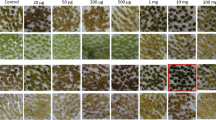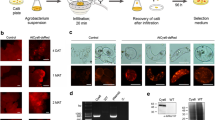Summary
One descendant of the Medicago sativa Ra-3 transformant T304 was analysed with respect to the somatic stability of the synthetic phosphinothricin-N-acetyltransferase (pat) gene which was used as a selective marker and was under the control of the 5′/3′ expression signals of the cauliflower mosaic virus (CaMV) gene VI. In order to quantify gene instability, we developed a system for culturing and regenerating individual cells. Single cell suspension cultures derived from T304 and the ancestral non-transgenic M. sativa cultivar Ra-3, were established. The cells were regenerated into monoclonal calli. In transgenic calli, the phosphinothricin (Pt)-resistance phenotype was retained after more than 2 months of non-selective growth. In contrast, up to 12% of the suspension culture cells grown under non-selective conditions and at constant temperature (25° C) lost the herbicide-resistance phenotype within 150 days. Surprisingly, a heat treatment (37° C), lasting for 10 days, during the culture period resulted in an almost complete (95%) loss of the Pt resistance of the suspension culture cells. However, the frequency of cell division was identical in cultures grown under normal and heat treatment conditions. A biochemical test revealed that no phosphinothricin-N-acetyltransferase activity was present in heat treated, Pt-sensitive cells. The resistance level of the Pt-sensitive transgenic cells was equivalent to that of the wild-type cells. A PCR analysis confirmed the presence of the pat gene in heat treated, Pt-sensitive cells. From these results it is concluded that the Pt resistance gene was heat-inactivated at a high frequency in the M. sativa suspension cultures.
Similar content being viewed by others
References
Amasino RM, Powell ALT, Gordon MP (1984) Changes in TDNA methylation and expression are associated with phenotypic variation and plant regeneration in a crown gall tumor line. Mol Gen Genet 197:437–446
Bayer E, Gugel KH, Hägele K, Hagenmeier H, Jessipow S, König WA, Zähner H (1972) Stoffwechselprodukte von Mikroorganismen. Phosphinothricin und Phosphinothricyl-alanyl-alanin. Helv Chim Acta 55:224–239
Beaucage SL, Caruthers HM (1981) Desoxynucleoside phosphoramidites: a new class of key intermediates for desoxypolynucleotide synthesis. Tetrahedron Lett 22:1859–1862
Budar F, Thia-Toong L, Van Montagu M, Hernalsteens JP (1986) Agrobacterium — mediated gene transfer results mainly in transgenic plants transmitting T-DNA as a single Mendelian factor. Genetics 114:303–313
Collasius M, Falk H, Ciesler C, Valet G (1989) How to build an inexpensive cyclotherm instrument for automated polymerase chain reactions. Anal Biochem 181:163–166
Damiani F, Pezzotti M, Arcioni S (1985) Variation among plants regenerated from tissue culture of Lotus corniculatus L. Z Pflanzenzüchtung 94:332–339
De Block M, Bottermann J, Vandewiele M, Dockx J, Thoen C, Gossele V, Movva NR, Thompson C, Van Montagu M, Leemans J (1987) Engineering herbicide resistance in plants by expression of a detoxifying enzyme. EMBO J 6:2513–2518
Doerfler W (1983) DNA methylation and gene activity. Annu Rev Biochem 52:93–124
Dröge W, Broer I, Pühler A (1992) Transgenic plants containing the phosphinothricin-N-acetyltransferase gene metabolize the herbicide L-phosphinothricin (glufosinate) differently from untransformed plants. Planta 187:142–151
Eckes P, Vijtewaal B, Donn G (1989) Synthetic gene confers resistance to the broad spectrum herbicide L-phosphinothricin in plants. J Cell Biochem Suppl 13 D
Evans DA (1989) Somaclonal variation — Genetic basis and breeding applications. Trends Genet 5:46–50
Farcy E, Cornu A (1979) Isolation and characterization of anthocyanin variants from the unstable system an2-1 in Petunia hybrida. Theor Appl Genet 55:273–278
Faugeron G, Rhounim L, Rossignol JL (1990) How does the cell count the number of ectopic copies of a gene in the premeiotic inactivation process acting in Ascobolus immersus. Genetics 124:585–591
Gelvin SB, Karcher SJ, DiRita VJ (1983) Methylation of the T-DNA in Agrobacterium tumefaciens and in several crown gall tumours. Nucleic Acids Res 11:159–174
Hepburn AG, Clarke LE, Pearson L, White J (1983) The role of cytosine methylation in the control of nopaline synthase gene expression in a plant tumor. J Mol Appl Genet 2:315–329
John MC, Amasino RM (1989) Extensive changes in DNA methylation patterns accompany activation of a silent T-DNA ipt gene in Agrobacterium tumefaciens-transformed plant cells. Mol Cell Biol 9:4298–4303
Jorgensen R (1990) Altered gene expression in plants due to trans interactions between homologous genes. Trends Biotechnol 8:340–344
Kao KN, Michayluk MR (1975) Nutritional requirements for growth of Vicia hajastana cells and protoplasts at a very low population density in liquid media. Planta 126:105–110
Kondo Y, Shomura T, Ogawa Y, Tsuruoka T, Watanabe H, Totsukawa K, Suzuki T, Moriyama C, Yoshida J, Inouye S, Niida T (1973) Studies on a new antibiotic SF-1293. I. Isolation and physiochemical and biological characterization of SF-1293 substance. Sci Rep Meiji Seika Kaisha 13:34–41
Lea PJ, Joy KW, Ramos JL, Guerrero MG (1984) The action of the 2-amino-4-(methylphosphinyl)-butanoic acid (phosphinothricin) and its 2-oxo-derivative on the metabolism of cyanobacteria and higher plants. Phytochemistry 23:1–6
Linn F, Heidmann I, Saedler H, Meyer P (1990) Epigenetic changes in the expression of the maize A1 gene in Petunia hybrida: Role of numbers of integrated gene copies and state of methylation. Mol Gen Genet 222:329–336
Lorimer G (1981) The carboxylation and oxygenation of the ribulose 1,5-bisphosphate carboxylase: The primary events in photosynthesis and photorespiration. Annu Rev Plant Physiol 32:349–383
Matzke MA, Matzke AJM (1990) Gene interactions and epigenetic variation in transgenic plants. Dev Genet 11:214–223
Matzke MA, Matzke AJM (1991) Differential inactivation and methylation of a transgene in plants by two suppressor loci containing homologous sequences. Plant Mol Biol 16:821–830
Matzke MA, Primig M, Trnovsky J, Matzke AJM (1989) Reversible methylation and inactivation of marker genes in sequentially transformed tobacco plants. EMBO J 8:643–649
Meyer P, Linn F, Heidmann I, Meyer zu Altenschildesche H, Niedenhof I, Saedler H (1992) Endogenous and environmental factors influence 35S promoter methylation of a maize A1 gene construct in transgenic petunia and its colour phenotype. Mol Gen Genet 231:345–352
Mittelsten Scheid O, Paszkowski J, Potrykus I (1991) Reversible inactivation of a transgene in Arabidopsis thaliana. Mol Gen Genet 228:104–112
Müller AJ, Mendel RR, Schiemann J, Simoens C, Inze D (1987) High meiotic stability of a foreign gene introduced into tobacco by Agrobacterium-mediated transformation. Mol Gen Genet 207:171–175
Mullis KB, Faloona FA (1987) Specific synthesis of DNA in vitro via a polymerase catalysed chain reaction. Methods Enzymol 155:335–350
Murashige T, Skoog F (1962) A revised medium for rapid growth and bioassays with tobacco tissue cultures. Physiol Plant 15:473–497
Otten L, de Greve H, Hernalsteens JP, Van Montagu M, Schieder O, Straub J, Schell J (1981) Mendelian transmission of genes introduced into plants by the Ti plasmids of Agrobacterium tumefaciens. Mol Gen Genet 183:209–213
Potrykus I, Paszkowski J, Saul MW, Petruska J, Shilito RD (1985) Molecular and general genetics of a hybrid foreign gene introduced into tobacco by direct gene transfer. Mol Gen Genet 199:169–177
Rogers SO, Bendisch AJ (1987) Extraction of DNA from milligram amounts of fresh, herbarium and mummified plant tissue. Plant Mol Biol 5:69–76
Spangenberg G, Koop HU, Lichter R, Schweiger HG (1986) Microculture of single protoplasts of Brassica napus. Physiol Plant 66:1–8
Strauch E, Wohlleben W, Pühler A (1988) Cloning of a phosphinothricin-N-acetyl transferase from Streptomyces viridochromogenes Tü494 and its expression in Streptomyces lividans and E. coli. Gene 63:65–74
Tepfer D (1983) The biology of genetic transformation of higher plants by Agrobacterium rhizogenes. In: Pühler A (ed) Molecular genetics of the bacteria-plant interaction. Springer Verlag, pp 248–258
Thompson CJ, Rao Mova N, Tizard R, Crameri R, Davies JE, Lauwereys M, Botterman J (1987) Characterisation of the herbicide resistance gene bar from Streptomyces hygroscopicus. EMBO J 6:2519–2523
USDA (1990) United States Department of Agriculture. Permits issued for release into the environment under 7CFR 340
Van Brunt J (1985) Non-recombinant approaches to plant breeding. Bio Technology 3:975–979
Wohlleben W, Arnold W, Broer I, Hillemann D, Strauch E, Pühler A (1988) Nucleotide sequence of the phosphinothricin-N-acetyltransferase from Streptomyces viridochromogenes Tü494 and its expression in Nicotiana tabacum. Gene 70:25–37
Author information
Authors and Affiliations
Additional information
Communicated by H. Saedler
Rights and permissions
About this article
Cite this article
Walter, C., Broer, I., Hillemann, D. et al. High frequency, heat treatment-induced inactivation of the phosphinothricin resistance gene in transgenic single cell suspension cultures of Medicago sativa . Molec. Gen. Genet. 235, 189–196 (1992). https://doi.org/10.1007/BF00279360
Received:
Accepted:
Issue Date:
DOI: https://doi.org/10.1007/BF00279360




